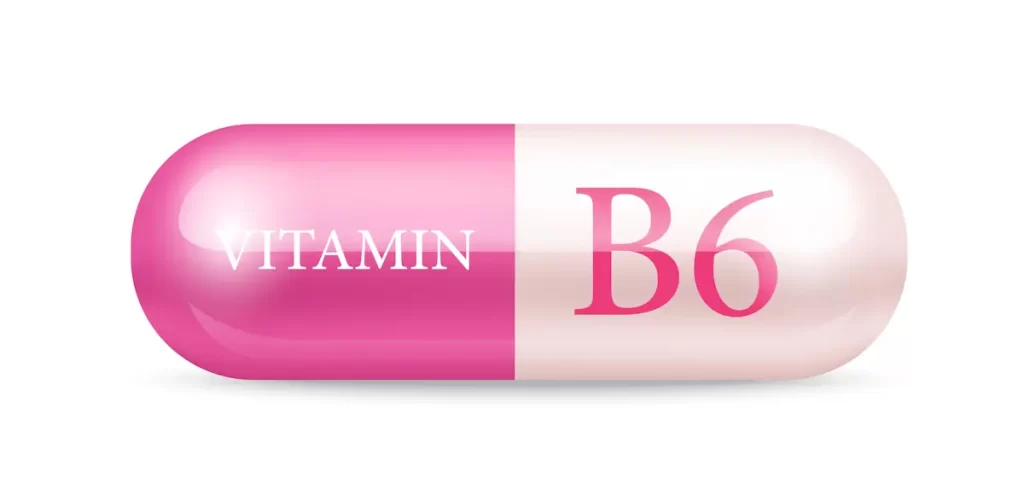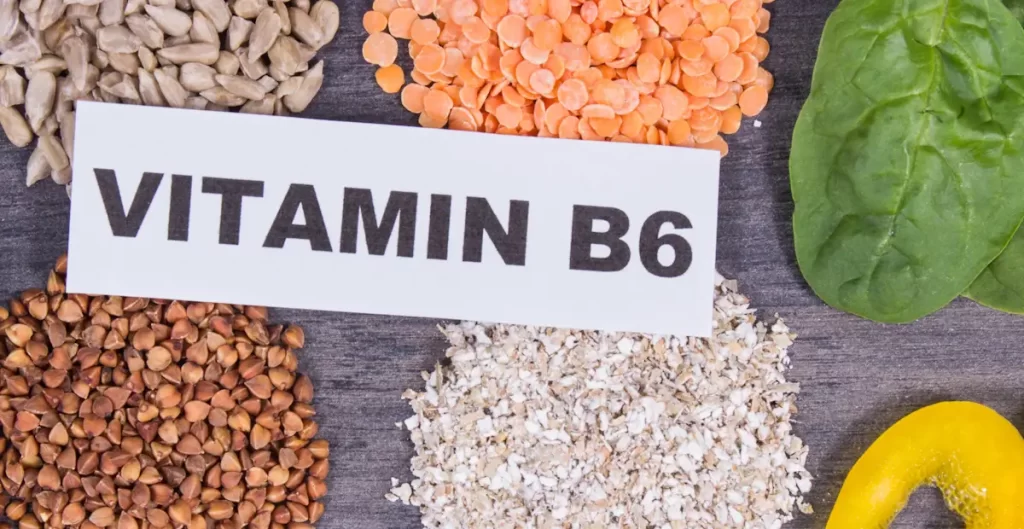Feeling tired, moody, or struggling with focus? Vitamin B6 plays a big role in keeping your mind and body healthy. This blog will explain its benefits, food sources, and why it matters for you.
Thank you for reading this post, don't forget to subscribe!Keep reading—it’s simpler than you think!
Key Takeaways
- Vitamin B6 supports mood, brain health, and red blood cell production. It helps regulate neurotransmitters like serotonin and prevents anemia.
- Daily needs vary by age and gender. Adults under 50 need 1.3 mg daily; men over 51 need 1.7 mg, and women over 51 require 1.5 mg per day in the U.S.
- Foods high in Vitamin B6 include meat (beef liver, chicken), fish (tuna, salmon), fruits (bananas, avocados), vegetables (potatoes, spinach), legumes (chickpeas), whole grains, and fortified cereals.
- High doses of Vitamin B6 may cause nerve damage or interact with medications like Levodopa or cancer drugs if not taken correctly—follow medical advice to avoid risks.
- Deficiency affects groups like those with kidney issues, autoimmune disorders, or alcohol dependence—leading to fatigue, confusion, or weakened immunity without proper care.
Recommended Daily Intakes of Vitamin B6
The daily intake of vitamin B6 depends on age and gender. Men and women aged 14 to 50 need 1.3 mg per day. For those over 51, men require 1.7 mg daily, while women need 1.5 mg each day.
Children over four and adults should aim for a Daily Value (DV) of 1.7 mg according to U.S guidelines. The tolerable upper limit (UL) is set at 100 mg per day for adults in the U.S., but as of 2023, Europe recommends staying below 12 mg daily to avoid risks like nerve damage or sensory changes.
Key Benefits of Vitamin B6
Vitamin B6 affects many parts of the body, including your mood, brain, and blood health. It plays a big role in keeping you healthy by helping with energy use and reducing certain risks.
Enhances Mood and Reduces Depression Symptoms
High doses of Vitamin B6 help reduce stress, anxiety, and depression symptoms. It plays a key role in producing serotonin and GABA—chemical messengers that regulate mood. These neurotransmitters create calmness and improve mental health.
A study with 478 people showed reduced stress levels after taking Vitamin B6 compared to a placebo group. Combining magnesium with this nutrient further boosts activity while lowering stress.
This powerful duo supports emotional well-being effectively.
Supports Brain Health and Cognitive Function
Vitamin B6 helps the brain make neurotransmitters, which send messages in the body. These are key for memory, learning, and mood stability. Low levels of this vitamin can cause confusion or depression.
Older adults with higher Vitamin B6 levels show better memory performance.
This nutrient keeps homocysteine balanced in your blood. High homocysteine levels may harm brain function and link to cognitive decline or Alzheimer’s disease. Eating foods rich in Vitamin B6, like bananas and spinach, supports long-term brain health.
“Vitamin B6 is vital not just for physical health but also mental clarity and sharpness.”
Aids in Hemoglobin Production and Prevents Anemia
Helps your body make hemoglobin, which carries oxygen in red blood cells. Low levels of this nutrient can lead to microcytic anemia, causing fatigue and weakness. Pregnant women are at higher risk of anemia if they lack vitamin B6.
A study showed daily 75 mg supplements improved symptoms in pregnant women with anemia. Foods like beef liver and fortified cereals help provide the needed intake for healthy red blood cell production.

Alleviates Symptoms of Premenstrual Syndrome (PMS)
Vitamin B6 can ease PMS symptoms like mood swings, depression, and irritability. Studies suggest doses up to 100 mg per day may show results for treatment. It helps by balancing neurotransmitters in the brain, which regulate emotions.
Combining Vitamin B6 with zinc strengthens its benefits for PMS relief. Many women report fewer cramps and better moods after using these nutrients together. Always check with a doctor before starting new supplementation.
Reduces Nausea During Pregnancy
Easing premenstrual symptoms links closely to managing pregnancy challenges. Many pregnant women face nausea, especially during the first trimester. Taking 25 mg of Vitamin B6 every eight hours has been shown to cut down morning sickness and vomiting effectively.
Studies report a major drop in nausea scores after therapy.
Combining Vitamin B6 with doxylamine improves results even further—reducing symptoms by up to 70%. The American College of Obstetricians and Gynecologists (ACOG) recommends doses ranging from 10–25 mg, taken three or four times daily, for relief.
This water-soluble vitamin offers a safe option for managing discomfort without harming the baby.
Lowers Risk of Heart Disease by Preventing Clogged Arteries
Vitamin B6 helps lower homocysteine levels in the blood. High homocysteine can lead to clogged arteries, increasing heart disease risk. Studies show people with low Vitamin B6 are nearly twice as likely to develop heart issues.
A combination of Vitamin B6 and folic acid has shown positive effects on heart health. It reduces abnormal heart test results and supports better blood flow by preventing clots from forming.
Adequate intake is key for maintaining a healthy cardiovascular system.
May Help Prevent Certain Types of Cancer
Higher plasma PLP levels, a marker of vitamin B6, are linked to a 30%-50% lower risk of colorectal cancer. Studies show that people with low B6 status often face increased inflammation.
Chronic inflammation can raise the chance of developing certain cancers.
A meta-analysis confirmed higher PLP levels reduce colorectal cancer risk. Genetic factors and poor diets may weaken this protective effect. Eating foods rich in vitamin B6 or taking supplements could help maintain healthy PLP levels.
Promotes Eye Health and Prevents Eye Diseases
Vitamin B6 helps protect your eyes. Studies show consuming more than 2.34 mg daily can lower glaucoma risk by 75%. This vitamin has strong antioxidant properties that fight damage to eye cells.
It may also reduce the risk of age-related macular degeneration (AMD). AMD is a common cause of vision loss in older adults. Including foods rich in Vitamin B6, like bananas and fortified cereals, supports long-term eye health.
Reduces Inflammation in Conditions like Rheumatoid Arthritis
Healthy eyes need proper care… but reducing inflammation also matters, especially for chronic conditions like rheumatoid arthritis (RA). Studies show that Vitamin B6 helps lower inflammation in RA patients.
In one trial with 35 individuals, the experimental group took 100 mg/day of B6 along with 5 mg/day of folic acid.
The results were clear. Levels of pro-inflammatory markers like IL-6 and TNF-alpha dropped significantly in this group. This reduction can ease joint swelling and pain caused by RA.
Adding more B vitamins to your diet may support overall health while managing inflammatory conditions better.

Dietary Sources of Vitamin B6
Vitamin B6 is found in many foods like meat, fish, fruits, and vegetables—making it easy to add to your diet. Keep reading to discover more options!
Meat (Beef, Chicken, Pork)
Beef, chicken, and pork are rich in Vitamin B6. A 3-ounce serving of beef liver provides 0.9 mg of Vitamin B6, meeting 53% of your daily value (DV). Chicken breast is another great option with 0.5 mg per 3 ounces or about 29% DV.
These meats help maintain energy levels by supporting protein metabolism.
Including these sources in your meals can increase red blood cell production and aid brain health. Beef liver stands out as one of the most nutrient-packed options among meats for this water-soluble vitamin…
Next up: fish and seafood!
Fish and Seafood
Tuna and salmon are fantastic sources of Vitamin B6. A 3-ounce serving of tuna provides 0.9 mg, which is about 53% of the daily value (DV). Similarly, a 3-ounce portion of salmon offers 0.6 mg, covering around 35% DV.
Including fish in your meals can boost brain health and lower the risk of heart disease. These water-soluble vitamins also play a role in energy production and reducing inflammation linked to rheumatoid arthritis.
Fish like tuna support red blood cell formation and aid protein metabolism for better overall health.
Fruits (Bananas, Avocado)
Bananas are a convenient and healthy snack. A medium banana provides 0.4 mg of vitamin B6, which is 25% of your daily value (DV). They’re also rich in carbohydrates, making them a quick energy source.
Adding bananas to your diet can support brain health and reduce morning sickness during pregnancy.
Avocados are packed with vitamin B6, fiber, and healthy fats. These nutrients help lower inflammation and promote heart health. They also aid in protein metabolism by assisting the body’s ability to break down amino acids and fats properly.
Avocados make a creamy addition to meals or snacks while boosting immune function naturally.
Vegetables (Potatoes, Spinach)
Potatoes are a great source of vitamin B6. A medium-sized potato provides about 0.4 mg, which is 25% of your daily value (DV). They are also starchy vegetables, making them filling and versatile for meals.
Eating potatoes helps support energy production and red blood cell formation.
Spinach offers a range of nutrients, including vitamin B6. It contributes to better brain health and reduces inflammation due to its rich profile. Adding spinach to salads or cooked dishes can boost overall nutrition effortlessly…
Next up: Legumes like chickpeas and lentils!
Legumes (Chickpeas, Lentils)
Chickpeas and lentils are great sources of vitamin B6. One cup of chickpeas provides 1.1 mg, covering 65% of your daily value (DV). These legumes also support heart health by improving cholesterol levels and reducing the risk of cardiovascular disease.
Lentils, rich in vitamins and minerals, play a role in a healthy gut. They help digestion due to their high fiber content. Including these legumes in your meals boosts energy, supports red blood cells, and promotes overall well-being.
Whole Grains and Cereals
Whole grains and cereals are rich in Vitamin B6. Fortified cereals provide about 0.4 mg per serving, meeting 25% of the daily value. They also offer other important nutrients like fiber, folate, and iron.
Brown rice, oatmeal, and whole wheat bread contribute to a balanced diet. These foods support energy levels and protein metabolism. Including them helps maintain immune function and reduce inflammation risks.
Fortified Foods
Fortified foods can boost your intake of Vitamin B6. These include cereals, energy bars, and meal replacements. Many popular breakfast cereals are rich in this nutrient. They often contain enough Vitamin B6 to help meet daily needs.
Studies show 28-36% of people choose fortified options or supplements for added nutrition. This makes it easier for those with limited diets to get essential vitamins. Fortified items also support individuals at risk of vitamin deficiencies, like those with certain health conditions.
Vitamin B6 Supplements
Vitamin B6 supplements can help fill gaps in your diet. They are useful if you struggle to meet the recommended intake through food alone.
When to Consider Supplementation
Pregnancy often increases the need for vitamin B6. Women experiencing morning sickness may benefit from supplements, with typical doses of 10-25 mg taken three to four times daily.
It helps manage nausea and vomiting effectively.
People on certain medications or with health conditions like kidney disease might also require extra B6. Deficiencies can lead to symptoms such as weakness or anemia, so supplementation becomes useful in these cases.
Always stick to safe dosages below the tolerable upper intake level (100 mg/day).
Recommended Forms and Dosages
Pyridoxine hydrochloride is the most common form of Vitamin B6 supplement. Adults are advised to stay under a tolerable upper intake level (UL) of 100 mg per day to avoid risks. The recommended dietary allowance (RDA) varies by age and life stage.
For example, men and women aged 19-50 need 1.3 mg daily, while pregnant individuals require 1.9 mg.
Supplements often help those with severe deficiencies or specific health needs like morning sickness or premenstrual syndrome (PMS). Always follow guidelines for safe use. Avoid high doses without medical advice since excess Vitamin B6 can cause nerve damage or tingling sensations in limbs over time.

Potential Risks and Side Effects of Excessive Vitamin B6
Taking too much vitamin B6 can lead to health problems. It may affect your nerves and cause unusual sensations or discomfort.
Nerve Damage and Sensory Changes
High doses of vitamin B6 can harm nerves. This may cause tingling, burning feelings, or numbness in the hands and feet. Some people report these issues even at doses lower than 50 mg per day.
Peripheral neuropathy gets worse with long-term use or combining many B6 supplements.
Nerve damage linked to excess vitamin B6 intake is often reversible after stopping it. But ignoring the symptoms could lead to lasting problems. To stay safe, avoid exceeding the tolerable upper intake level (UL), set at 100 mg daily for adults.
Always check labels on dietary supplements to prevent overuse.
Interaction with Medications
Excessive vitamin B6 intake may interfere with certain medications. Drugs like Levodopa, used for Parkinson’s disease, can become less effective if combined with high doses of vitamin B6.
Some anticonvulsants and barbiturates may also interact negatively, reducing their benefits.
Cancer treatments such as Altrethamine may lose effectiveness when mixed with this vitamin. Always consult your doctor before taking supplements—especially if you’re on prescription medication.
Groups at Risk of Vitamin B6 Deficiency
Certain health conditions can make people more prone to vitamin B6 deficiency. Lifestyle factors, such as poor diet or excessive alcohol use, may also increase the risk.
Individuals with Impaired Renal Function
People with chronic renal insufficiency or on dialysis often face vitamin B6 deficiency. The kidneys play a key role in processing this water-soluble vitamin, but damaged kidneys struggle to do so.
This increases the risk of health problems like microcytic anemia, skin rashes (dermatitis), and depression due to low levels.
Impaired immune function is another concern among these individuals. A weakened system may make it harder to fight infections. Regular monitoring and possible supplementation of vitamin B6 can help prevent complications linked to its deficiency in such cases.
Those with Autoimmune Disorders
Autoimmune disorders can make it harder for the body to absorb vitamin B6. This can lead to a deficiency over time. Symptoms such as confusion, depression, and fatigue may appear if levels drop too low.
A weakened immune system is another common issue linked to these conditions.
Rheumatoid arthritis and ulcerative colitis are examples of autoimmune diseases that may increase this risk. Ensuring proper intake through diet or supplements helps maintain brain health, mood balance, and energy levels.
People with Alcohol Dependence
People with alcohol dependence often lack vitamin B6. Alcohol affects how the body absorbs and uses this water-soluble vitamin. Over time, it can lead to a deficiency.
This deficiency increases the risk of anemia, depression, and confusion. A weakened immune system is another common problem. Lower energy levels may also occur due to poor protein metabolism.
Moving forward, other groups are also at risk of vitamin B6 deficiency….
Vitamin B6 and Overall Health
Vitamin B6 helps your body process proteins, fats, and carbs for energy. It also strengthens your immune system—learn how this vitamin keeps you healthy!
Role in Metabolizing Proteins, Fats, and Carbohydrates
This vitamin helps break down proteins, fats, and carbohydrates into smaller parts. It supports over 100 enzyme reactions to make this possible. For example, it converts carbs into glucose for energy.
Proteins are broken into amino acids needed for body repair and growth.
Fats also require its help to produce essential fatty acids. These processes keep your energy steady throughout the day. Balanced metabolism from Vitamin B6 ensures better overall health and nutrient absorption…
Leading next to its role in boosting immune function!
Importance in Immune Function and Energy Levels
Vitamin B6 helps the immune system work better. It supports over 100 enzymatic reactions, keeping your body ready to fight illnesses. Low levels of this vitamin weaken defense mechanisms, making it harder for you to stay healthy during infections.
This nutrient also plays a key role in energy production. Active forms like PLP help convert proteins, fats, and carbohydrates into usable energy. Without enough B6, fatigue can set in quickly.
Next—foods rich in Vitamin B6!
Conclusion
Vitamin B6 plays a key role in keeping your body healthy and strong. It helps your mind, blood, and immune system work well. Eating foods rich in B6 or taking supplements can fill any gaps if needed.
Stay balanced with the right amount to avoid risks. Small steps like this can lead to better health every day!
For more information on how vitamins play a crucial role in your wellness journey, discover the health benefits and sources of Vitamin B7 (Biotin).
